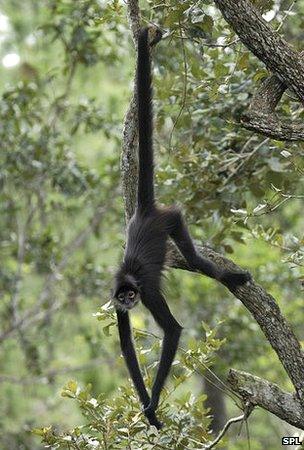International trade 'driving nature loss'
- Published

The black-handed spider monkey is hanging on in the face of habitat loss for coffee and cocoa
Almost a third of threats to animal species around the world stem from trade to meet the demands of richer nations, a study concludes.
Forests are cut down for coffee and cocoa plantations, removing animal habitat; elephants and rhinos are poached to provide ivory to East Asia.
Researchers analysed the overall impact of all this on threatened species.
Writing in the journal <link> <caption>Nature</caption> <url href="http://www.nature.com/" platform="highweb"/> </link> , they say management of supply chains and product labelling could help stem the trend.
The mainly Australian research team looked at nearly 7,000 threatened species drawn from the internationally recognised <link> <caption>Red List</caption> <url href="http://www.iucnredlist.org/" platform="highweb"/> </link> .
These records were cross-referenced against analyses of more than 15,000 commodities and traced back through international supply chains.
The overall picture is one where goods whose production damages biodiversity flow from developing countries into their more prosperous counterparts - although this is becoming more complex as economies such as China quickly develop.
Previous studies have found that western demand for such commodities as Brazilian beef, Indonesian palm oil, Mexican coffee production and Vietnamese fishing was harming nature.
But this is believed to be the first attempt to document the global impact of trade on biodiversity.
Other significant issues identified include rubber exports from Malaysia, exploitative fishing in the Philippines and Thailand, production of bananas and tobacco in Colombia, and minerals mining in Ghana.
Purchasing disparity
The US, Japan and Western Europe emerge as the main places where demand is driving biodiversity loss in exporting countries, while Indonesia and Madagascar are the two countries where wildlife is most under threat as a result of international demands.
There are also some examples of high impact trade between neighbouring countries - for example, Mexican goods flowing into the US, and Malaysian produce into Singapore.
The report's authors suggest that both labelling and supply chain management can be deployed as tools against this loss.
Campaigns such as the one mounted in the 1970s against tuna caught using methods that harmed dolphins have on occasion been very successful, persuading western consumers to boycott companies whose products did not live up to their demands.
More recently, companies such as Nestle have decided to source raw materials from suppliers that agree to meet environmental standards - for example, pledging not to destroy virgin rainforest in order to grow palm oil.
The scientists also argue that governments could implement trade sanctions.
The UN Convention on International trade in Endangered Species (CITES) obliges governments to restrict trade in species that have reached a parlous state of existence.
The scientists suggest that "there is no practical difference in terms of imperilment between trading specimens and trading commodities whose production leads to their imperilment.
"The motivation for banning the first kind of trade equally applies to the second kind, and, consequently, trade in biodiversity-implicated commodities should be governed by the same control and licensing procedures."
Follow Richard <link> <caption>on Twitter</caption> <url href="http://twitter.com/#!/┤¾¤¾┤½├¢RBlack" platform="highweb"/> </link>
- Published21 March 2012
- Published18 April 2012
- Published15 September 2011
- Published2 September 2011